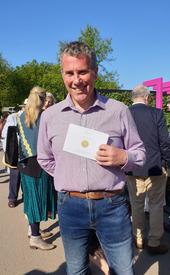
The Montessori Centenary Children’s Garden has been designed by the horticulturist and educator Jody Lidgard, (below), who aimed to bring a child-centric approach and highlight the multi-sensory nature of a Montessori classroom. It is the first time he has designed a garden for the show. ‘Visitors to Chelsea may be surprised by the imperfect look of this garden,’ he said. ‘This is a space that is designed to be experienced and enjoyed by children, teaching them about the natural world and allowing them to explore horticulture in their own way.’
‘Visitors to Chelsea may be surprised by the imperfect look of this garden,’ he said. ‘This is a space that is designed to be experienced and enjoyed by children, teaching them about the natural world and allowing them to explore horticulture in their own way.’
After the show, the Space to Grow garden will initially move to Montessori Centre International's training centre in St John's Wood. However, there are plans for it to be permanently based at the V & A Museum of Childhood in Bethnal Green to provide a natural teaching space for families in the local community.
The area has a history of being linked to Montessori, as suffragette Sylvia Pankhurst used the Montessori approach to set up the Mother’s Arms nursery in Bow.
The garden’s many playful features include a raised dipping pond to make it more accessible for children, featuring glass gargoyles that drip water from the wall above, and a water play station allowing children to learn about measurement, and sinking and floating.
Register now to continue reading
Thank you for visiting Nursery World and making use of our archive of more than 35,000 expert features, subject guides, case studies and policy updates. Why not register today and enjoy the following great benefits:
What's included
-
Free access to 4 subscriber-only articles per month
-
Unlimited access to news and opinion
-
Email newsletter providing activity ideas, best practice and breaking news
Already have an account? Sign in here
